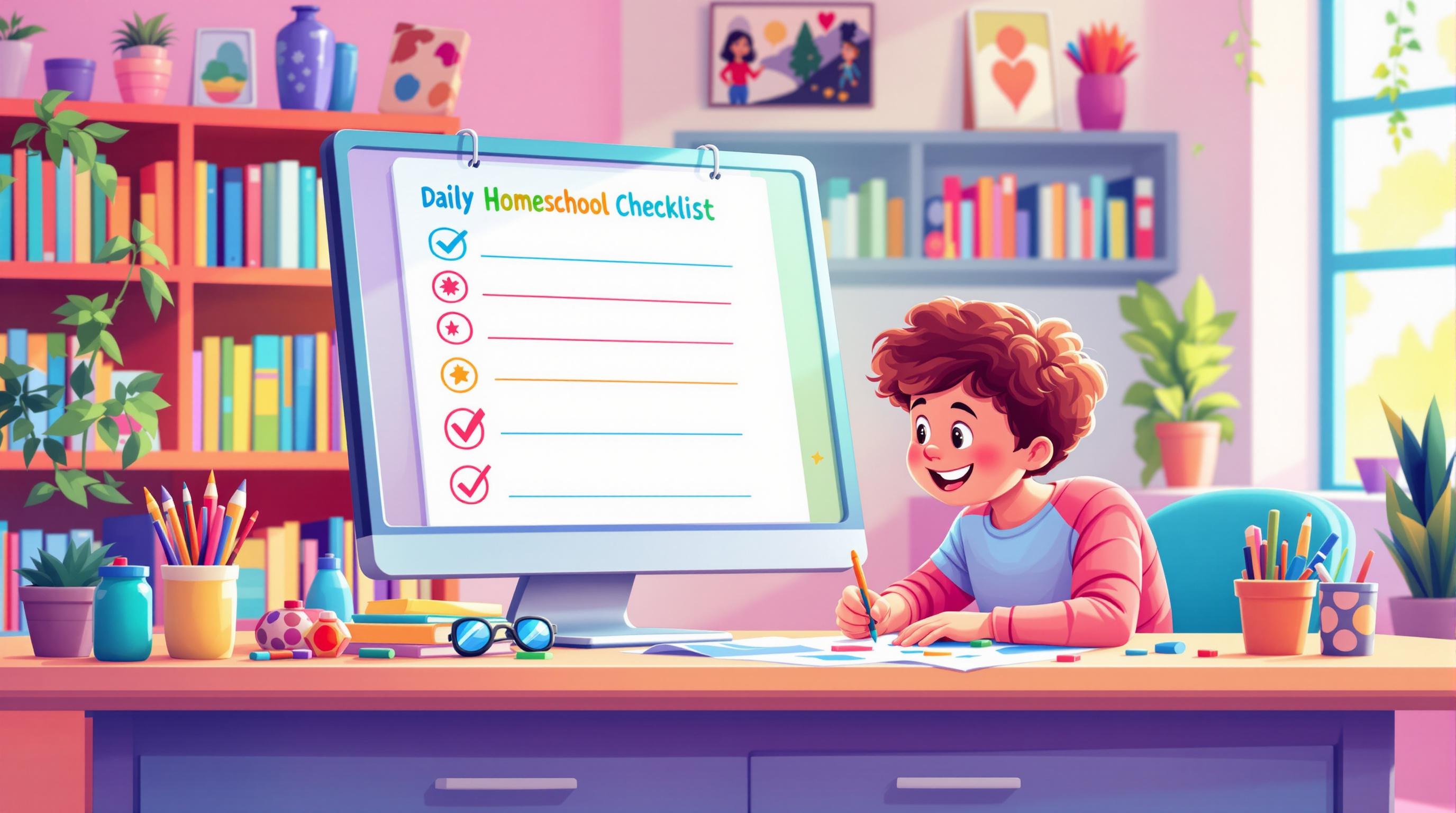Customizing assistive technology can help children grow and become more independent. By tailoring tools like text-to-speech apps, adaptive keyboards, or sensory aids to a child’s specific needs, you can improve their learning experience, focus, and confidence.
Key Takeaways:
- Personalized Tools: Match tools to your child’s strengths (e.g., speech-to-text for verbal learners).
- Collaborate with Experts: Work with educational consultants or therapists for assessments and guidance.
- Regular Updates: Adjust tools based on your child’s development and changing needs.
- Daily Routines: Gradually integrate assistive tech into lessons for smoother adoption.
- Community Support: Use resources like the Homeschool Directory and forums for advice and recommendations.
Start small, track progress, and adapt as needed to create a flexible learning environment that evolves with your child.
Simple Homeschool Assistive Technology Integration Ideas
Evaluating Your Child's Needs
Understanding what your child needs is key to picking and tailoring assistive technology that works best for them. A step-by-step evaluation helps pinpoint the tools and adjustments that will truly help in their learning journey.
Identifying Strengths and Challenges
The first step is to get a clear picture of how your child learns. Pay close attention to how they interact with learning materials. Here are some key areas to observe:
| Area of Focus | What to Look For |
|---|---|
| Learning Style | Do they prefer visual aids, listening, or hands-on activities? |
| Communication | How do they best express themselves - speaking, writing, or other methods? |
| Physical Abilities | How are their motor skills, coordination, and ability to use devices? |
| Attention Span | How long can they stay focused, and what helps or distracts them? |
| Technology Comfort | Are they already familiar with devices, and how quickly do they adapt to new ones? |
Take detailed notes. For example, if your child struggles with traditional keyboards but excels in verbal communication, speech-to-text software could be a great fit. Observing these details helps you make informed decisions.
Working with Professionals
Experts can provide valuable insights through structured assessments, helping you understand where technology can make the biggest difference. Here's what to expect during this process:
- Initial Assessment: Specialists observe your child in different learning situations to identify their strengths and challenges.
- Collaborative Planning: You'll work together to create a customized plan that aligns with your child's educational goals and daily needs.
- Regular Reviews: Periodic evaluations ensure the tools are still meeting your child’s needs as they grow and their skills evolve.
Resources like the Homeschool Directory can connect you with professionals who specialize in assistive technology and homeschooling.
Keep in mind, this isn’t a one-time process. As your child develops new abilities or faces new challenges, their technology needs may change. Regularly reviewing and adjusting their tools ensures they continue to get the right support.
Once you’ve got a clear understanding of their needs, the next step is introducing the right tools into your homeschooling routine.
Implementing Assistive Technology
Once you've identified your child's needs, the next step is to start using assistive technology in a way that feels natural and effective. This section offers tips to help you introduce these tools smoothly, ensuring both you and your child feel confident and at ease.
Starting with Simple Tools
Start by addressing your child's most pressing challenges with straightforward tools. Build their confidence before moving on to more advanced options. Introduce tools gradually, focusing first on basic features (1-2 weeks), then on daily use (2-4 weeks), and finally on blending them into lessons (4-6 weeks).
| Phase | Focus Areas |
|---|---|
| Introduction | Learning basic features |
| Practice | Establishing daily routines |
| Integration | Using tools in lessons |
Creating a Routine
Kick off each day by checking devices and setting aside time to explore new features. Plan regular breaks to keep activities balanced and review progress daily to make adjustments as needed. Organize your homeschooling schedule to include assistive tools during the times your child is most focused and alert.
Key steps for success:
- Check devices each morning.
- Set specific times for practice.
- Include breaks to avoid fatigue.
- Review progress daily and make necessary tweaks.
Learning and Support for Families
Take advantage of resources like online tutorials, community forums, and support groups to learn alongside your child. Keep a record of their progress to identify what’s working and what needs improvement. The Homeschool Directory is a helpful resource, offering tutorials and connecting you with other homeschooling families who are also using assistive technology.
Remember, learning to use assistive tools is a process. Start small and expand your knowledge over time. The better you understand these tools, the more effectively you can support your child's learning journey.
As your child gets more comfortable with these tools, it’s essential to regularly evaluate their effectiveness and adjust to any changing needs - something we’ll cover in the next section.
sbb-itb-fb77983
Updating Technology as Needs Change
As your child grows, their needs for assistive technology will shift. Regularly reviewing and adjusting these tools ensures they stay helpful and relevant.
Regularly Checking Effectiveness
Use this table to evaluate how well the tools are working:
| Assessment Area | Key Questions | Frequency |
|---|---|---|
| Academic Progress | Is the tool helping achieve learning goals? | Monthly |
| Usability | Can your child use the tool independently? | Bi-weekly |
| Technical Fit | Are there any device or software issues? | Quarterly |
| Skill Development | Do the tools match your child's current abilities? | Every 3 months |
Noticeable changes - like improved skills, new challenges, or reduced interest - could indicate it’s time for adjustments.
Trying New Tools
When considering updates, test new tools thoroughly before committing. Start with trial versions if available and introduce changes gradually, keeping familiar tools as backups during the transition.
Key factors to consider when evaluating tools:
- Compatibility: Make sure the tools work well with existing systems and come with tutorials or support.
- Learning curve: Allow 2–4 weeks to see how well the tool fits into daily use.
- Cost: Assess whether the tool is worth the investment.
Collaborate with occupational therapists or educational consultants to ensure the tools align with your child’s development and learning style. During the trial phase, document what works and what doesn’t to make informed decisions about long-term use.
After updating, tap into community resources for support and fresh ideas to maximize the tools’ effectiveness.
Using Resources and Community Support
Finding trustworthy resources and connecting with helpful communities can simplify the process of selecting assistive technology and make it more effective.
Online Resources for Assistive Technology
TechMatrix provides a searchable database filled with assistive tools, step-by-step guides, and training materials to help match specific learning challenges with the right solutions. Assistive Technology Act programs also offer support through:
| Resource Type | What You'll Find | Best Used For |
|---|---|---|
| Tool Database | A catalog of assistive devices | Locating specific tools or solutions |
| Guides and Tools | Frameworks for evaluation and setup guides | Choosing and implementing tools |
| Training Materials | Tips for troubleshooting and using tools | Learning to use devices effectively |
The Homeschool Legal Defense Association (HSLDA) provides legal advice and strategies tailored to integrating assistive technology into homeschooling environments.
Using the Homeschool Directory

The Homeschool Directory connects families with a wide range of resources, forums, and reviews designed for homeschooling. Key features include:
- Curated Educational Materials: Pre-selected tools and resources created specifically for homeschooling families.
- Community Forums: Spaces where parents exchange experiences and tips on using assistive technology.
- Product Reviews: Honest feedback from families who have tried different tools in their home education setups.
"Parents report that sharing experiences in forums often leads to discovering innovative ways to adapt tools effectively" [1]
Participating in these forums can offer practical advice for customizing tools to fit your child’s changing needs. Staying active in these communities also helps you stay informed about new tools and strategies.
Conclusion: Growth Through Customization
Customizing assistive technology helps create a learning environment that evolves alongside your child. This process takes commitment, regular evaluations, and a readiness to make changes when necessary.
Consistency Builds Confidence
Incorporating assistive tools into daily routines helps your child get comfortable and skilled with them. Over time, these tools become a natural part of their learning process.
Professional Collaboration and Support
Keep communication open with specialists to decide when changes are needed or to explore new resources. Regular input from professionals ensures your child’s needs are addressed as they develop.
"Assistive technology allows parents to customize their child's learning experience to suit their unique learning abilities." [2]
Building Independence
Introducing tools that match your child’s skill level can help them gain academic confidence. With regular practice, they’ll improve their technical skills, and by encouraging feedback, you’ll help them develop self-advocacy.
Continuous Assessment
Keep an eye on how tools are working by tracking your child’s preferences, frustration levels, and independence. Adjust as needed to align with their growth and any new challenges.
This process - evaluating, implementing, and updating tools - creates a flexible learning environment tailored to your child’s progress. Personalized tools, structured routines, and ongoing support lay the groundwork for meaningful development. Connecting with homeschooling communities can also help you find additional resources and ideas.
FAQs
How does assistive technology affect student learning?
Assistive technology (AT) plays a key role in helping students, especially in homeschooling settings. Studies indicate that AT can address specific learning challenges, particularly in areas like reading and spelling [1][2].
Encouraging Independence
AT empowers students to handle tasks on their own, reducing the need for constant help from parents or teachers. This independence not only boosts confidence but also encourages students to take an active role in their learning [1][2].
Tailored Learning Tools
Assistive tools are designed to address individual challenges and can be adjusted as students grow. For instance, a simple text-to-speech tool might later be replaced with advanced comprehension aids as reading skills improve [1].
Long-Term Benefits
The success of AT often hinges on regular updates and adjustments. When used effectively, these tools can:
- Help students develop skills at every stage of learning
- Adjust to new academic demands
- Build comfort with technology
- Promote self-sufficient learning
"Assistive technology allows parents to customize their child's learning experience to suit their unique learning abilities." [2]
Working with professionals ensures that the tools meet your child’s specific needs and educational goals. Resources like the Homeschool Directory can guide families in making informed decisions about assistive technology as their children grow and face new challenges.


